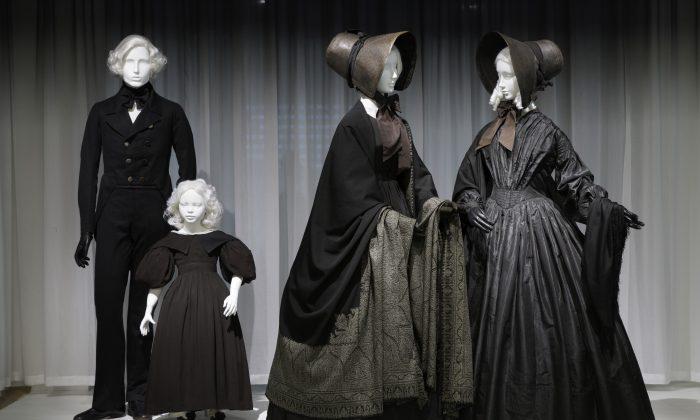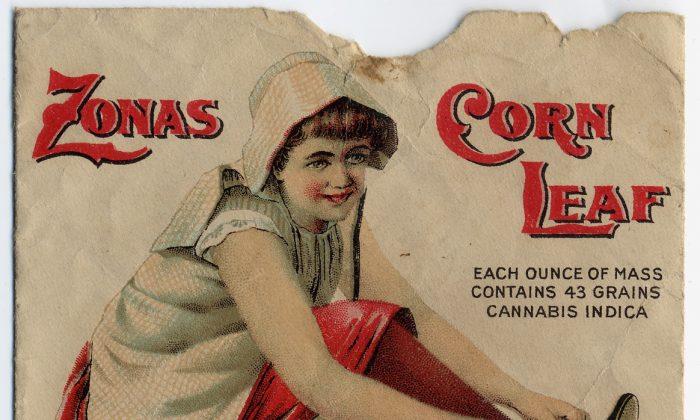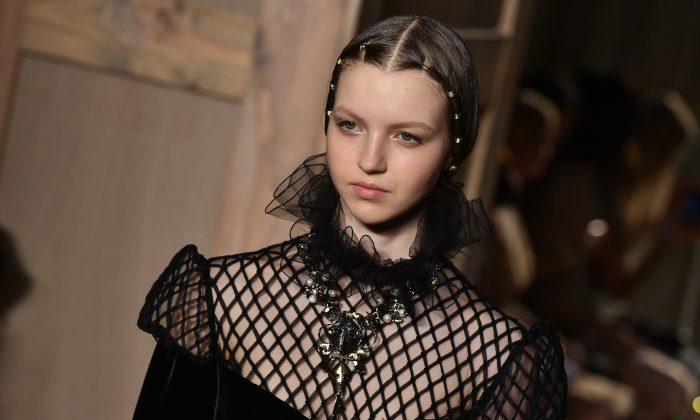Death, as experienced by those left behind to mourn, takes on many forms and customs. Once the actual ceremonies for the departed are over, personal bereavement continues and is expressed in various ways.
In fashion, there have been many rules for one’s attire when in mourning, and some still apply today, but they are far less binding than in past decades and centuries. However, for the most part of history, widows have found ways of adorning their mourning outfits while still observing the hue associated with loss—black.
“Death Becomes Her: A Century of Mourning Attire,” The Costume Institute’s first fall exhibition in seven years, is currently on view in The Metropolitan Museum of Art’s Anna Wintour Costume Center. The exhibition explores the aesthetic development and cultural implications of mourning fashions of the 19th and early 20th centuries and the beginnings of our love affair with black.
Despite the etiquette of bereavement, which dictates “nun-like simplicity” in dress, the fashions donned by ladies in mourning, according to Harper’s Bazaar in 1868, have almost never adhered to such austerity.
In composition, with fabrics in contrasting textures, the ensembles displayed in the exhibition range from plain dresses to more elaborate mourning outfits. In form, however, it is immediately obvious that the silhouette never reverted to, or even alluded to, any nun-like simplicity.
According to Jessica Regan, assistant curator of the exhibition, the chronological arrangements of the exhibition allowed her and curator Harold Koda to emphasize the evolution of the silhouette. And it is clear that despite the radical change in color, the shapes of the garments were always compliant with the fashionable silhouette in any given decade.
Alongside the dresses on display in the exhibition, there are also pages from ladies magazines of the day that illustrate the latest fashions. In one colorful page out of the Parisian “Le Moniteur de la Mode” of 1871, there are two ladies depicted, one is wearing a white dress with lilac ribbons and trim, while the other has an outfit with as much textural variety and detail that could possibly fit onto a garment, though it is all in black.
The Three Stages of Mourning
Regan explains that the adherence to the different stages of mourning and their corresponding fabrics and hues depended on the community to which people belonged.
The most formal etiquette dictated that garments worn during the first stage of mourning were made of matte black silk crepe. During the second-stage, somewhat lustrous fabrics such as taffeta, poult de soie, and moiré were permissible. By the third stage, color could be reintroduced, in a restrained way however, through various trims in burgundy, gray, and black and white.
The Allure of Black
Given their resources, royalty were more observant of the three stages of mourning, and as the styles they wore filtered through to the middle classes, having a really good quality black dress became a symbol of status.
Higher end fabric retailers promised that the color would not fade into a dark reddish brown, but remain a true deep black.
For the same reason that wearing black is prevalent today as a personal fashion preference, widows in 19th and early 20th centuries must have noticed how black tends to accentuate the silhouette—even if this was not explicitly noted.
In fact wearing black became fashionable as early as the 19th century, a trend that was indignantly noted in Harper’s Bazaar of Aug. 9, 1879: “Black is more than ever the favorite color of fashion. There was a time—our mothers will remember it—when the sole fact of wearing a black dress when one was not in mourning was sufficient to call forth a kind of reprobation, and to cause the wearer to be classed among the dangerously eccentric women.”
The quote is one of the many projections of text that fade in and out on the walls of the somber exhibition. They provide great insights into the attitudes toward bereavement and the effect of one’s choices to express it through fashion.
Widowhood
Equally fascinating is the stereotype of the young widow whose newly gained financial independence combined with the experience of married life made her a powerful figure to behold. According to Koda, “The veiled widow could elicit sympathy as well as predatory male advances. As a woman of sexual experience without marital constraints, she was often imagined as a potential threat to the social order.”
This theme is richly developed in a series of satirical illustrations also on display, by Charles Dana Gibson, titled “A Widow and Her Friends,” that appeared in Life magazine between 1900 and 1901.
The illustrations depict a sultry young widow during her daily activities and in society. Each frame attempts to show her out of her comfort zone, as any widow was sure to feel, yet the artist allows little more than ennui to be the predominant expression on her face.
Memories and Mementos
On exhibition are also jewelry pieces that, apart from serving as adornment, were primarily for the purpose of memorializing the departed. Among the most compelling pieces are those containing hair woven into ornate forms, encapsulated in glass and framed with precious stones.
Jet, a kind of fossilized wood, was a popular material that lent itself to either being polished or left matte. On show is a huge, sculptural black necklace with both chain and pendants carved out of what must have been great chunks of jet.
As surely as the absolute opaqueness of death could be expressed through black, the inevitability of life was also expressed through decorations, such as fruit, or delicate motifs and textural interest through manipulating fabric for aesthetic purposes.
The most poignant example of this contrast of ideas is displayed in a mourning hat from circa 1915, which is literally overflowing with an abundance of grapes, vine leaves, and even small curled up vines. In color, it would have been a celebration of life; in black, it might have meant that the bounty of life and enjoyment of it has been dulled by the loss of a loved one. If worn to the funeral of a not-so-beloved person, it could have easily taken on different connotations.
So despite the sometimes rigid etiquette of mourning, there was clearly room for personal expressions of grief, the nuances of which would have been far greater than the prescribed monochrome to which one had to adhere.
“Death Becomes Her: A Century of Mourning Attire” is on view in The Metropolitan Museum of Art’s Anna Wintour Costume Center through Feb 1, 2015.





Friends Read Free